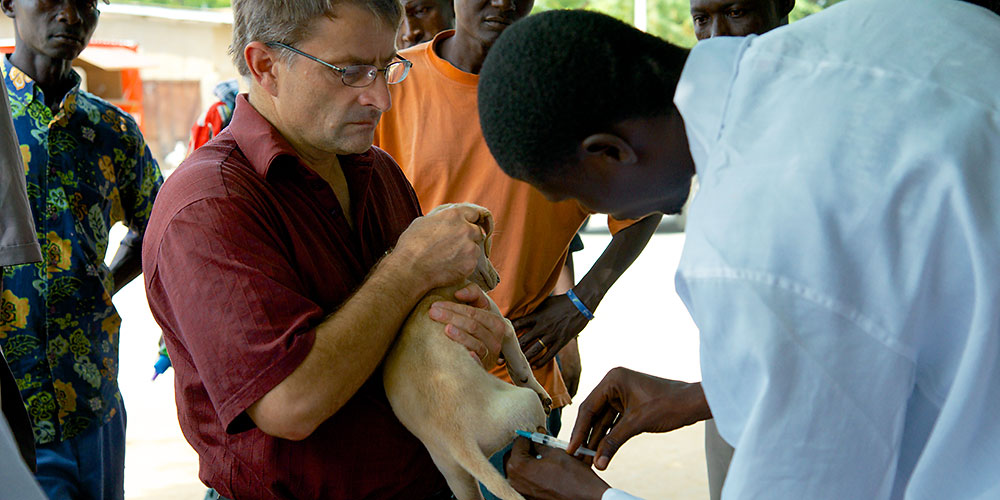Study Reveals Feasibility of Eliminating Rabies in Africa
The Swiss Tropical and Public Health Institute, together with European and African collaborators, carried out a mass dog vaccination in Chad and determined its effect on human rabies exposure. The study employed a bio-mathematical method for estimating the transmission dynamics of rabies. The researchers conclude that with political will and the necessary funding, elimination of rabies is possible in Africa. The study was published in Science Translational Medicine.
20 December 2017
Rabies is a viral disease that kills tens of thousands of people every year, predominantly in Africa and Asia. The disease is transmitted through the bites of infected dogs and foxes. In West and Central Europe, rabies was eliminated some 20 years ago. Switzerland was declared free of rabies in 1999 after implementing a strategy targeting foxes.
“If you want to prevent humans from dying from rabies in Africa and Asia, you need to eliminate dog rabies,” said Jakob Zinsstag, Professor of Epidemiology at the University of Basel and a group leader at the Swiss Tropical and Public Health Institute (Swiss TPH). Swiss TPH, together with collaborators in Europe and Africa, demonstrated the proof-of-concept that elimination of rabies is feasible.
“We have shown that African teams in one of the poorest countries can eliminate human rabies through mass vaccination of dogs. What is needed next is additional funding and a concerted political will,” said the veterinary public health expert.
The investigation was carried out in N’Djamena, the capital of Chad where 1.1 million people live alongside some 30,000 dogs. In 2012 and 2013, 20,000 dogs were vaccinated each year against rabies. Hence, more than 65% of the city’s estimated dog population participated in the intervention, “an excellent coverage rate,” said Zinsstag. “We mobilized the neighborhood chiefs and they, in turn, mobilized the people and their dogs.”
African-European collaboration
Swiss TPH collaborated with a public-private partnership in Chad, namely the Centre de Support en Santé Internationale (CSSI) and the Institut de recherche en élevage pour le développement (IRED). An additional player was the Laboratoire Central Vétérinaire (LCV) in Bamako, Mali.
For the genetic analyses of collected rabies viruses, Swiss TPH was supported by the ETH Zurich in Basel, Switzerland, and by the Institut Pasteur in Paris, France. At Swiss TPH, an interdisciplinary team was established with expertise in molecular diagnostics, mathematical modelling and veterinary epidemiology.
"The mathematical modelling shows that the reproductive number that is the number of secondary infections for one rabies-infected dog fell under one, hence transmission is interrupted, and a molecular analysis shows that the circulating strains disappear," said Zinsstag and Nakul Chitnis, a co-investigator at Swiss TPH.
Further insights through phylodynamics
The study is one of the first research projects to apply a rigorous phylodynamic method to dog rabies, and hence, it expands upon the normative phylogenetics (i.e., assessing the genetic relatedness of virus strains) with the dynamics of transmission over time. This made it possible to calculate the reproductive number of rabies among the dogs after the first mass dog vaccination in 2012.
“Dog rabies was likely re-introduced through the import of dogs by humans from outside N’Djamena after the rabies elimination had been achieved,” Zinsstag explains. The phylogenetic analysis supports this finding since the sequence of nucleoprotein of the new viruses showed a different genetic structure. "The molecular method ascertained the results put forth by the mathematical model through an independent approach," said Zinsstag. “Therefore eliminating rabies is not a technical problem, but a matter of political will and sufficient financial resources.”
Elimination of rabies in Central and West Africa
As a next step, Swiss TPH – an associated institute of the University of Basel – and its partners plan to extend mass dog vaccination against rabies across Chad. "We have calculated that with 28 million Euros, it would be possible to eliminate rabies throughout the country. However, an important challenge is migration: once Chad is free from rabies, the disease might be re-imported from neighboring countries such as Cameroon and Sudan.”
"We, therefore, need a concerted Pan Central and West African approach, led by the Economic Unity of West African States ECOWAS and the African Union. This would bring along the additional benefit of promoting peace through cooperation." Zinsstag estimates that to free Central and West Africa from rabies, the costs would amount to around one billion Euros over a 20-year period.
Original source
Jakob Zinsstag, Monique Lechenne, Mirjam Laager, Rolande Mindekem, Service Naïssengar, Assandi Oussigéré, Kebkiba Bidjeh, Germain Rives, Julie Teissier, Seraphin Madjaninan, Mahamat Ouagal, Daugla D. Moto, Idriss O. Alfaroukh, Yvonne Muthiani, Abdallah Traoré, Jan Hattendorf, Anthony Lepelletier, Lauriane Kergoat, Hervé Bourhy, Laurent Dacheux, Tanja Stadler, Nakul Chitnis
Vaccination of dogs in an African city interrupts rabies transmission and reduces human exposure
Science Translational Medicine (2017), doi: 10.1126/scitranslmed.aaf6984
Further information
Anna Wegelin, Swiss TPH, Head of Communications, tel. +41 284 86 83, cell: +41 76 588 30 06, email: anna.wegelin@swisstph.ch



